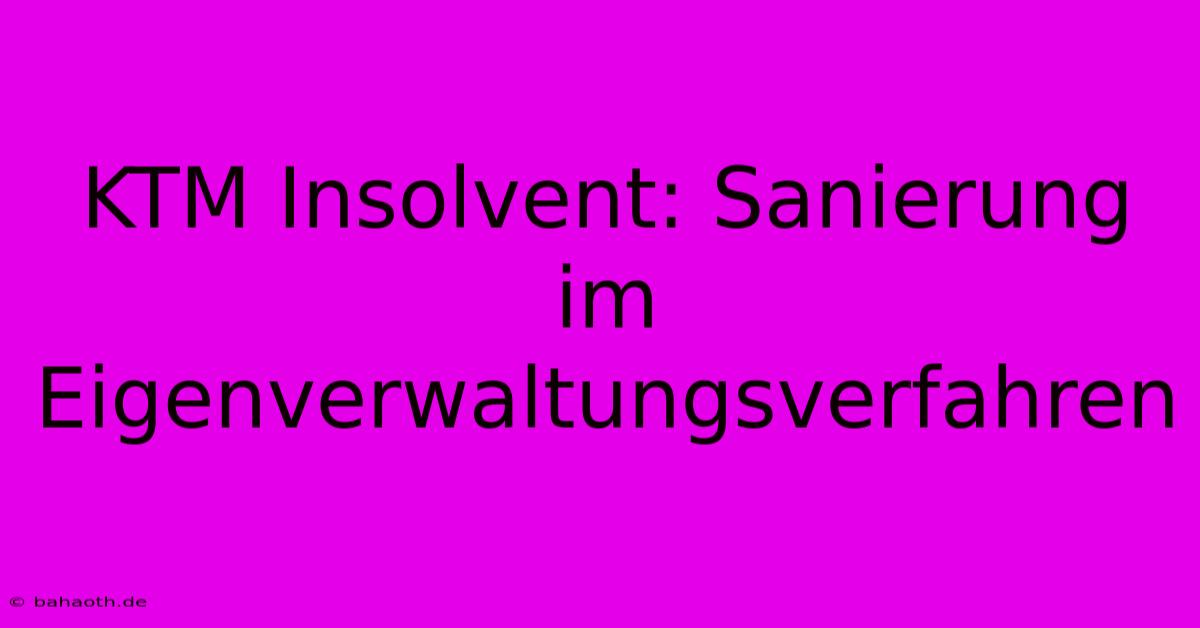KTM Insolvent: Sanierung Im Eigenverwaltungsverfahren

Discover more detailed and exciting information on our website. Click the link below to start your adventure: Visit Best Website KTM Insolvent: Sanierung Im Eigenverwaltungsverfahren. Don't miss out!
Table of Contents
KTM Insolvent: Sanierung im Eigenverwaltungsverfahren – Ein Fallbeispiel für die Motorradindustrie
Okay, folks, let's talk about something that's been making waves in the motorcycle industry – the recent insolvency filing by KTM. I know, ouch. It's a big deal, especially for those of us who are passionate about bikes. This isn't just some small, fly-by-night operation; we're talking about KTM, a name synonymous with performance and innovation. So what happened? And what does it mean for the future of the brand? Let's dive in.
What is Eigenverwaltungsverfahren?
First things first, let's clarify what "Eigenverwaltungsverfahren" means. In simple terms, it's a type of insolvency proceeding where the company's management remains in control, guided by a court-appointed administrator. Think of it as a controlled restructuring, a chance for the company to reorganize its finances and operations without immediate liquidation. It's a bit like a financial "boot camp," designed to whip the company into shape. This process is common in Germany and other parts of Europe, offering a lifeline to struggling businesses. This differs significantly from a Chapter 11 filing in the US, but shares similar aims.
My own experience with this type of financial restructuring was… let’s just say it was educational. I once advised a small business during a similar process, and the level of detail needed to prepare the required documentation was astounding. It was a massive undertaking, like organizing a thousand-piece jigsaw puzzle while riding a unicycle! But through meticulous planning, we managed to turn things around. That’s why I can tell you that a transparent and well-structured plan is absolutely crucial for success during Eigenverwaltungsverfahren.
KTM's Situation: What Went Wrong?
The exact reasons behind KTM's financial difficulties are complex and haven't been fully disclosed. However, industry analysts point to a few key factors:
- Supply Chain Issues: Like many businesses, KTM struggled with global supply chain disruptions following the pandemic. Getting parts and materials became a nightmare – increased costs and delays hammered profit margins. It’s a problem that many companies are still dealing with.
- Increased Competition: The motorcycle market is fiercely competitive. KTM faces pressure from established players and newer, disruptive brands. Maintaining market share requires constant innovation and aggressive marketing—and that costs money.
- Economic Downturn: The recent economic slowdown has impacted consumer spending, leading to reduced demand for premium motorcycles. Folks are tightening their belts, and luxury items like high-performance bikes often take a hit first.
The Road to Recovery: What's Next for KTM?
KTM's future depends heavily on the success of its restructuring plan. The plan will likely involve:
- Cost Reduction: Expect to see measures to streamline operations and reduce expenses. This might mean tough decisions about staffing and production.
- Focus on Core Strengths: KTM might prioritize its most profitable product lines and potentially divest from less successful ventures.
- Strategic Partnerships: We might see KTM forging alliances with other companies to share resources and expand its market reach.
Lessons Learned & SEO Considerations
This whole KTM situation highlights the importance of:
- Diversification: Don't put all your eggs in one basket. A diversified product portfolio can help cushion the blow of economic downturns.
- Supply Chain Resilience: Building strong, reliable supply chains is crucial for mitigating risk.
- Adaptability: The ability to adapt to changing market conditions is essential for long-term survival.
From an SEO perspective, this whole situation provides some valuable lessons. Writing about trending topics like this one (remember to include relevant keywords like "KTM Insolvency", "Eigenverwaltungsverfahren", "Motorradindustrie") is great for attracting traffic. But more important than just chasing trends is creating high-quality, informative content that genuinely helps people understand what's going on.
So there you have it. My take on KTM's insolvency and the Eigenverwaltungsverfahren. It's a complicated situation, but it's also a fascinating case study in business resilience. We'll be watching closely to see how things unfold. What are your thoughts? Let's chat in the comments!

Thank you for visiting our website wich cover about KTM Insolvent: Sanierung Im Eigenverwaltungsverfahren. We hope the information provided has been useful to you. Feel free to contact us if you have any questions or need further assistance. See you next time and dont miss to bookmark.
Featured Posts
-
Eigenverwaltung Ktm Ag Kaempft Ums Ueberleben
Nov 27, 2024
-
Champions League City Verliert 3 3 Klar Einfach Direkt Zum Punkt
Nov 27, 2024
-
Prestigeduell Bayern Gewinnt Leverkusen Siegt
Nov 27, 2024
-
Atalanta Zerlegt Young Boys 6 1
Nov 27, 2024
-
Gewinnt Irlands Linke Noch
Nov 27, 2024
